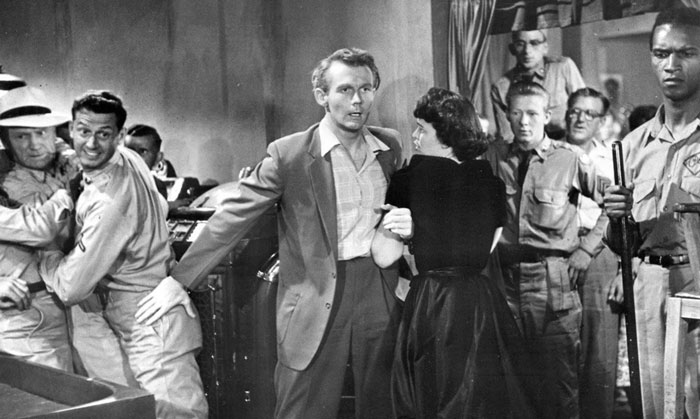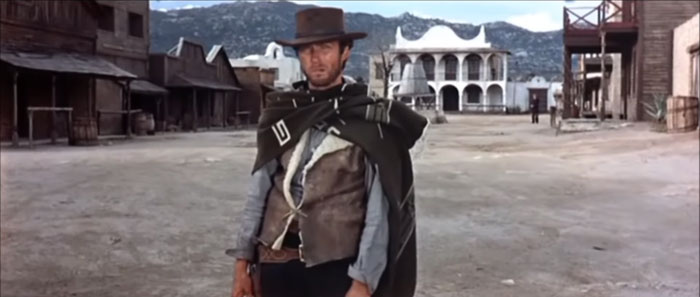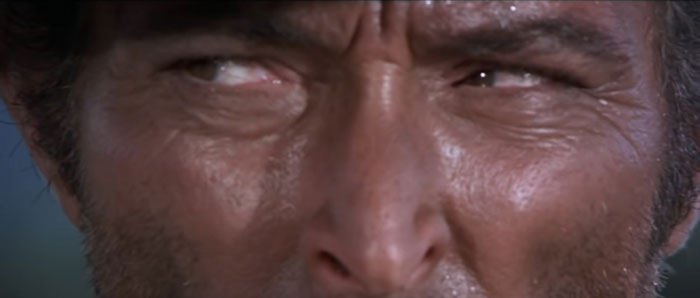FREE Film School: Know the Shots 2 – Medium Shots
Last week I talked about 3 different filmmaking shot styles: extreme long (wide), long (wide) and full. This week we’ll look at some more shots and see how they are used in well known films.
I’m a filmmaker and, even though I’m in my mid 50s, I’m still learning. Any reason why we should stop learning as we move into the latter half of our lives? I mean, sometimes I think I’m only just now getting the hang of things.
So, whatever stage you’re at, there’s always space to discover something new. And just hearing an alternative opinion on something can teach you a new trick or two. Plus it keeps us fresh and helps us to avoid getting stuck in a rut of old habits.
But what’s that go to do with filmmaking shots? Nothing! So let’s look at some more filmmaking shots…
Medium Long Shot
This shot is one step closer than the full shot (one must be careful not to type an “i” by accident, there. Which reminds me of when I use to work at the cinema. If one wanted to swap shifts with a coworker, a hasty email was often sent to everyone. And in that haste, once in a while the “f” would get lost, with amusing results. A Freudian slip perhaps…)
Anyway, this shot is halfway between the full shot and the medium shot. A subject will be captured from about the knees up. Well, the difference between this and the full and medium shots is clearly going to be subtle.
Why would we use such a shot? Perhaps we’re just being indecisive and can’t choose between full and medium, so what the hell. I’ve heard the words “split the difference” spoken by many a DoP while on set.
Including more in the frame without losing intimacy
If, in general terms, a close up shows emotion and a wide shows action, then a medium long shot will reveal a little more emotion whilst still showing most of the subjects actions. Take a look at this still frame from The Phenix City Story (Phil Karlson, 1955).

The scene is packed with emotional drama but there’s action to be conveyed too. While Karlson probably wanted to be close enough that the audience could see the subject’s expressions, he also wanted to include the extras reactions and show the physical action of the scene.
So, for this shot, we can see the supporting cast are creating a need for a wider shot than a medium or a close up. The action between the main cast and the other characters in the room also requires we show more. But if the shot was too wide, we might lose any sense of intimacy, emotion or engagement between the audience and the main cast.
Medium Shot
The medium shot is one of the most common shots in filmmaking, with the subject generally framed from the waist up. It’s close enough to reveal some of what is going on in the subject’s mind, whilst still giving a sense of their surroundings. In a way, with the medium shot we are still observing the “world around us”.
Most of our lives, as we move around – getting up, going to work, meeting friends, eating with the family and so on – we are aware of what’s going on nearby. However, we’re not usually so distracted that we’re looking into the distance. Especially if we have company.
Neither are we so introverted that our perception is limited to our own thoughts and feelings (ie: the close up). Not if we are generally function well within society. Perhaps, for example, if we are suffering a deep torment, we might then find ourselves less interested in what’s going on around us.
Filmmaking language very much mirrors the way people see the world. So, while the medium shot is common in film, equally in the real world humans often experience life this way.
Have a look at this clip from the movie Halloween (2018) and observe (unless you’re squeamish) the use of the medium shot. For about the first minute, there are mostly medium shots. Then as things start to get more tense, the camera moves closer to the subject’s face to read her emotions.
Balancing Emotion vs Action
This clip is a great example of the need to balance emotion vs action. For example, at the moment the lady on the toilet decides to flee, she lets out a cry. Normally, we’d get close to her face (as in previous shots). However, she has to first pull up her pants so she can run and the director has decided the audience needs to know this. And for that reason, the director (or editor) opts for a medium shot.
By the way, I’m really not a fan of these kind of horror films. But I do think they often demonstrate well this need to balance emotion vs action. You don’t get any higher emotion than the feeling of horror, yet horror films often include a lot action. Therefore, balancing the two can be quite tricky and requires some thought.
Cowboy Shot (aka American Shot)
As a variation of the medium shot, the Cowboy Shot is framed from the mid-thigh up. The shot was named after American Westerns which needed to include the gun and holster hanging from a cowboy’s hip.
Again, this is an emotion vs action decision: do we want to get close to the grizzled (or nervous) expression of a cowboy, or do we want to include the action of drawing and firing? Think of Sergio Leone’s Spaghetti Westerns, and the way he sometimes framed so tightly only the gunfighting actors’ narrowed eyes are in frame.
When Leone chose to frame so tightly, his aim was to really crank up the tension for the gunfights. Imagine yourself as one of the gunfighters in this scene from The Good, The Bad & The Ugly. Would you be focused on your opponents’ gun hand, or their eyes?
Because, in the scene, the fighters seem to be using the latter. Perhaps because they know eyes will more likely give their opponents’ first move away. Or maybe it just looks cool. Regardless, it sure does raise the tension of Leone’s trademark drawn-out gunfights.
Medium Close-Up
Moving a step closer to the subject, the medium close-up is halfway between the medium shot and the close-up. The shot frames a subject from the chest and shoulders up. Like the medium long-shot, this shot moves closer to reveal more emotion but hanging back a little to keep a bit more information in the frame.
How close we are to the subject often indicates the degree of intimacy in a scene. Again, think about how we behave as people. This from-chest-upwards framing roughly matches what we perceive when in conversation with someone.
So, in movies, you’ll often find this choice of framing when characters are engaged in dialogue, but which is not too intense. Therefore, this shot helps the audience to feel like they’re part of the conversation. This is something I talked about previously in my post about the 180 degree rule.
In this clip from Flawless (1999) we see a scene between Walt (Robert De Niro) and Rusty (Philip Seymour Hoffman). Seymour Hoffman opens the door to De Niro and the following conversation is conducted in medium close-up.
This reflects the level of drama and intimacy in the scene. Because, while the scene contains some emotion, it’s not dramatic or intense enough to demand a close up. Hanging back on a medium close-up allows the moment to breathe, while a close-up would probably be too claustrophobic at this moment in the story.
This Week’s FREE film School Exercise
Well, I think that’s enough to mull over for this week. And you can repeat last week’s exercise, except look out for medium long, medium, cowboy shots and medium close-ups. Think about how they fit into a sequence of shots and what emotions or ideas they’re trying to convey. We will never know what the director or DoP was actually thinking (unless they expressed it somewhere), but by mulling it over ourselves we get better at thinking like a filmmaker.
Again, look at your own projects and think about how these 3 shots might be used. If you want to go even further, you can try filming some sequences for practice and include them. As I always say, use what you have available (like every single successful filmmaker did before they got to earn a living at it).
If you can, recruit some volunteers and arrange a scene using these 3 shots. Either use your own idea for a scene or steal one from a movie, a book or a play. To help with the medium long shot, you might need more than 2 subjects to add extra action in a wider frame, but that’s up to you.
An Exercise in Framing and Editing
Film a scene from Shakespeare, or from Harry Potter, or something from the last book you read. It really doesn’t matter because this is just an exercise to build your experience and teach yourself filmmaking. You have a smartphone in your pocket/bag and it almost certainly shoots some form of video. And don’t worry about lighting and tripods and so on (unless you want to) this is really just framing and editing practice.
Once you’ve got some medium long, medium and medium close-ups captured, cut them together and see how it works. My tip is to shoot the entire scene each at each framing. So, go through the whole scene at medium long, then medium, then medium close-up.
Now, when you edit this all together there should be no missing parts of the scene because you covered it all from 3 angles. You can play with the action vs emotion of the scene by moving closer or further away. In addition, you can see how you can change the actors’ performance in the scene with your editing skills.
Eager to learn more?
Join our weekly newsletter featuring inspiring stories, no-budget filmmaking tips and comprehensive equipment reviews to help you turn your film projects into reality!
Simon Horrocks
Simon Horrocks is a screenwriter & filmmaker. His debut feature THIRD CONTACT was shot on a consumer camcorder and premiered at the BFI IMAX in 2013. His shot-on-smartphones sci-fi series SILENT EYE featured on Amazon Prime. He now runs a popular Patreon page which offers online courses for beginners, customised tips and more: www.patreon.com/SilentEye




